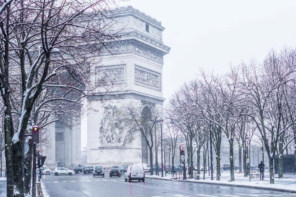
When I was deciding on the places to visit in Vietnam, I was hemming and hawing over including Hué or not. The country’s former imperial capital certainly looked fascinating, but would I be able to squeeze it into what was becoming a packed itinerary? I’d had mixed feedback from my friends who’d been there. Some loved it, others said it could be skipped. So I thought it could be helpful to share some insight into the matter with these five reasons to visit Hué (or not).
Located in the middle of Vietnam, set in from the coast on the picturesque Perfume River, Hué became the seat of Nguyen emperors who unified Vietnam after 300 years of Chinese rule. It was the nation’s capital from 1802 until the last emperor abdicated in 1945, handing over power to Ho Chi Minh and the subsequent shift of the capital to Hanoi. During this period it prospered and architecturally evolved with the vast Imperial Citadel with its sumptuous and mysterious “Forbidden Purple City,” along with the town’s other graceful pagodas and the nearby imperial tombs. Piqued your interest? Here are more things to consider.

1. If you have the time
I didn’t have all that much time in Vietnam, so I did have to pick and choose. If you’re backpacking around without a precise schedule or have 2 or more weeks in Vietnam than it would be a pity not to stop in Hué. In the end I only stayed in Hué for around 6 hours, which isn’t really enough time to visit the Imperial City as well as some of the Imperial Tombs and other sites, that is unless you take a taxi out to the tombs or do a tour, which I decided against… then regretted afterwards. A full day, either arriving around noon and staying overnight or arriving early in the morning and leaving in the evening, could suffice.
Hué is about 20 km inland from the coast, 100 km from Da Nang, 125 from Hoi An and 700 from Hanoi, it’s therefore logical to tuck it in between the latter two. I took the bus up from Hoi An… partially for the experience of trying out the famed Vietnamese sleeper-buses, partially due to the ease (and cost: about 5 dollars). The other option from Hoi An is the train, but you need to go into Da Nang for it. Travelers can also arrive from Hanoi by night bus/train or an easy flight, which is how I left Hué.
 2. If you’re a history buff
2. If you’re a history buff
I love history and always find that traveling to new places is like walking through a textbook. If you’re more interested in discovering Vietnam’s natural beauty or have a window into daily life, you might rather include Sapa, Halong Bay or the Mekong Delta.
When most people think of Vietnam, the wars generally come to mind first, not many know much about its earlier history. Therefore, Hué serves as a valuable location for learning about the Viet Nam as a whole and not just the city. Though Imperial Complex was highly damaged by a fire in 1947 and by bombs during the wars, there is still a lot to see and the remaining buildings have been gradually restored.

3. If you want insight into Vietnam’s overall history and culture
Even if you’re not a mega-history geek, but you’re inquisitive and want to know more about Vietnam, Hué is worth the stop. In addition to being the political center, it was the country’s cultural and religious heart. With such cultural significant and wealth, it’s no wonder that the grouping of Hué monuments have made its way onto the UNESCO World Heritage list. Merely walking through the different areas of the Imperial Citadel makes its history come to life, there are also museum sections with detailed explanations of court life, societal hierarchy, Vietnamese traditions and the of course a lot of information on the history of the palace. There are also temples within the complex which shed light into the country’s religious practice and a theatre where you can sample traditional Vietnamese music (for an additional fee).
Outside of the Imperial Citadel, there are a number of prestigious pagodas you can visit in the town, one of the most famous being the Thien Mu Pagoda (see tips on reaching it in the Extras section below). This Pagoda sits on a curve in the river and offers lovely views of the surrounding area. Since the tombs are out of town, you’ll have to consider your options to get there (organized tour, or do it yourself, more info on those Hué transport options and on the royal tombs here).

4. If you hate crowds
One of things I liked about the Imperial Citadel was the fact that there were so few people. Being slightly off season surely helped, nevertheless, the site is an under-visited gem, making it perfect for anyone who hates crowds or wants to do something a little more unique. Besides the main buildings near the front of the complex, I was often all by myself strolling peacefully through its secret corners and courtyards. I couldn’t help think back to my visit to the its imperial counterpart, the Forbidden City in Beijing, the massive masses of pushy tourists seriously detracting from enjoying it. Luckily there are some quieter areas to escape to, but so few in comparison to Hué.

5. If you’ve been to the Forbidden City in Beijing (or other royal palaces)
If you’ve been to China’s Forbidden City, there are many reasons why you’ll enjoy visiting Vietnam’s (aside from the bonus of no crowds). It’s really intriguing to see the similarities and differences between the two sites. I wonder if the designers of Hué’s had traveled to Beijing prior for some inspirations or how much say the emperors had the process and what else might have been borrowed (or rejected) from the big neighbor they’d just gained their autonomy from.
And if you need one more reason to go to Hué, it’s also fascinating to compare the citadel and the tombs to others you may have visited in other countries, whether it was France’s Versailles, Japan’s Osaka castle or the Egypt’s Valley of the Kings.
Extras:
So if you’ve been convinced to include Hué, here are a few other tips:
- It can get pretty hot walking around the Citadel, be sure to drink lots of water and wear comfortable shoes. There are plenty of little “shops” inside where you can buy cold water or snacks. You may want to eat outside though (I ate at a little place in the strip mall to the right of the palace, a cheap meal at a local place for about 2 dollars.
- I took a taxi from the Citadel to the Thien Mu Pagoda, it cost about 65,000 VND (about 2 dollars) make sure the driver puts on the meter.
- I took a private boat back down the river to the center, there are usually some boat drivers waiting there, I negotiated down to 80,000 VND around half what they were asking. I got a deal, but then he kept trying to sell me handmade postcards and other things (a beer didn’t seem like such a bad idea after walking and sweating all day). It was still a nice alternative to a taxi.
- You can skip the Loi Street “Market,” the rather touristy strip down on the south side of the river. Instead if you’d like a visit a market, stop in at the more authentic Dong Ba Market, situated about a kilometer to the east of the Citadel, across from the Trang Tien Bridge.
- Don’t leave town without trying their local specialty: Banh Khoai pancakes. They are more like a crepe and are filled with a variety of ingredients, these go well with the town’s own Hué Beer.
While planning your trip to the country, it’s help get your visa in advance. You can get here a Vietnam visa for French citizens, as well as other nationalities through their site. Passing through Hanoi on your way down to Hué. Check out these great Hanoi city tours to make the most of your time in Vietnam’s vibrant capital city!
Have a fabulous trip!






















